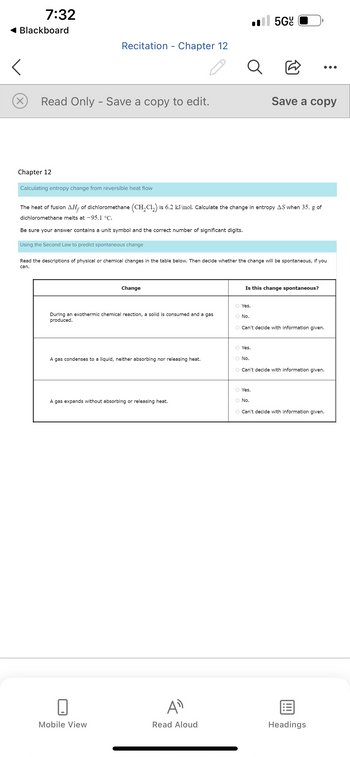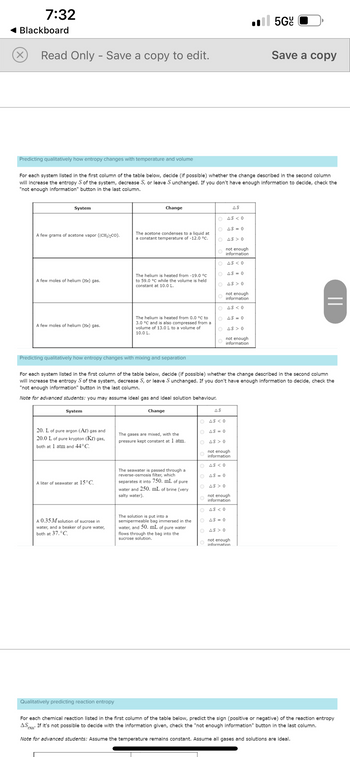
Chemistry
10th Edition
ISBN: 9781305957404
Author: Steven S. Zumdahl, Susan A. Zumdahl, Donald J. DeCoste
Publisher: Cengage Learning
expand_more
expand_more
format_list_bulleted
Question

Transcribed Image Text:7:32
Blackboard
Chapter 12
Recitation Chapter 12
X Read Only - Save a copy to edit.
Calculating entropy change from reversible heat flow
Using the Second Law to predict spontaneous change
-
Change
The heat of fusion AH, of dichloromethane (CH₂Cl₂) is 6.2 kJ/mol. Calculate the change in entropy AS when 35. g of
dichloromethane melts at -95.1 °C.
Be sure your answer contains a unit symbol and the correct number of significant digits.
During an exothermic chemical reaction, a solid is consumed and a gas
produced.
Mobile View
A gas condenses to a liquid, neither absorbing nor releasing heat.
A gas expands without absorbing or releasing heat.
Read the descriptions of physical or chemical changes in the table below. Then decide whether the change will be spontaneous, if you
can.
Q
AD
Read Aloud
.5Gº
O Yes.
O No.
@
Save a copy
Is this change spontaneous?
O Yes.
O No.
O Can't decide with information given.
O Can't decide with information given.
O Yes.
O No.
O Can't decide with information given.
Headings

Transcribed Image Text:7:32
Blackboard
×
Read Only - Save a copy to edit.
Predicting qualitatively how entropy changes with temperature and volume
System
For each system listed in the first column of the table below, decide (if possible) whether the change described in the second column
will increase the entropy S of the system, decrease S, or leave S unchanged. If you don't have enough information to decide, check the
"not enough information" button in the last column.
A few grams of acetone vapor ((CH3)₂CO).
A few moles of helium (He) gas.
A few moles of helium (He) gas.
System
20. L of pure argon (Ar) gas and
20.0 L of pure krypton (Kr) gas,
both at 1 atm and 44°C.
Predicting qualitatively how entropy changes with mixing and separation
A liter of seawater at 15°C.
Change
A 0.35 M solution of sucrose in
water, and a beaker of pure water,
both at 37.°C.
The acetone condenses to a liquid at
a constant temperature of -12.0 °C.
Qualitatively predicting reaction entropy
The helium is heated from -19.0 °C
to 59.0 °C while the volume is held
constant at 10.0 L.
The helium is heated from 0.0 °C to
3.0 °C and is also compressed from a
volume of 13.0 L to a volume of
10.0 L.
The gases are mixed, with the
pressure kept constant at 1 atm.
The seawater is passed through a
reverse-osmosis filter, which
separates it into 750. mL of pure
water and 250. mL of brine (very
salty water).
The solution is put into a
semipermeable bag immersed in the
water, and 50. mL of pure water
flows through the bag into the
sucrose solution.
AS
OAS < 0
O
AS = 0
O
AS > 0
not enough
information
O
For each system listed in the first column of the table below, decide (if possible) whether the change described in the second column
will increase the entropy S of the system, decrease S, or leave S unchanged. If you don't have enough information to decide, check the
"not enough information" button in the last column.
Note for advanced students: you may assume ideal gas and ideal solution behaviour.
Change
O
OAS < 0
OAS=0
O AS > 0
O
OAS < 0
O AS = 0
OAS 0
AS
OAS < 0
OAS = 0
O AS> 0
not enough
information
ΤΟ ΔS < 0
OAS=0
O AS >0
not enough
information
not enough
information
OAS <0
OAS = 0
O AS> 0
not enough
information
.5Gc
Save a copy
not enough
information
||
For each chemical reaction listed in the first column of the table below, predict the sign (positive or negative) of the reaction entropy
AS If it's not possible to decide with the information given, check the "not enough information" button in the last column.
rxn'
Note for advanced students: Assume the temperature remains constant. Assume all gases and solutions are ideal.
Expert Solution
This question has been solved!
Explore an expertly crafted, step-by-step solution for a thorough understanding of key concepts.
This is a popular solution
Trending nowThis is a popular solution!
Step by stepSolved in 3 steps with 2 images

Knowledge Booster
Learn more about
Need a deep-dive on the concept behind this application? Look no further. Learn more about this topic, chemistry and related others by exploring similar questions and additional content below.Similar questions
- The heat of fusion AH, of methanol (CH,OH) is 3.16 kJ/mol. Calculate the change in entropy AS when 23. g of methanol melts at -98.0 °C. Be sure your answer contains a unit symbol. Round your answer to 2 significant digits. 0 0 X H 010arrow_forwardWhich of the following definitions correlate to the term nonspontaneous process? O Change in entropy for a reaction calculated using the standard entropies Process that takes place without a continuous input of energy from an external source Possible configuration or arrangement of matter and energy within a system O Process that requires continual input of energy from an external sourcearrow_forwardThe CO2 sublimation heat is 16.2 kJ/mol and the entropy value of sublimation is 88.5 joules/mol. k (What temperature does CO2 sublimate at?arrow_forward
- A certain substance has an enthalpy of fusion of 6.12 kJ/mol and an entropy of fusion of 22.3 J/mol/K. Calculate the approximate melting point of the substance. Leave the answer in Kelvin.arrow_forwardTRUE OR FALSE According to the second law of thermodynamics Entropy of the universe decreases in real processes.arrow_forwardHI has a normal boiling point of –35.4°C, and its DHvapis 21.16 kJ/mol. Calculate the molar entropy of vaporization (DSvap). Be sure to include the correct units with your answer.arrow_forward
- Calculate the entropy change of 63.4 g of water that freezes into ice at 273.15 K. AHfus for water is 6.01 kJ/mol. J/Karrow_forwardCompare what will happen to the entropy of the whole system in the following two scenarios: A) if the oil molecules are all clumped together and the clump is surrounded by water and B) if the oil molecules are spread out evenly throughout the water, each individual oil molecule surrounded by water?arrow_forwardWhich one of the systems would have more entropy and why if there's 3 particles w a total energy of 12 Jarrow_forward
arrow_back_ios
arrow_forward_ios
Recommended textbooks for you
 ChemistryChemistryISBN:9781305957404Author:Steven S. Zumdahl, Susan A. Zumdahl, Donald J. DeCostePublisher:Cengage Learning
ChemistryChemistryISBN:9781305957404Author:Steven S. Zumdahl, Susan A. Zumdahl, Donald J. DeCostePublisher:Cengage Learning ChemistryChemistryISBN:9781259911156Author:Raymond Chang Dr., Jason Overby ProfessorPublisher:McGraw-Hill Education
ChemistryChemistryISBN:9781259911156Author:Raymond Chang Dr., Jason Overby ProfessorPublisher:McGraw-Hill Education Principles of Instrumental AnalysisChemistryISBN:9781305577213Author:Douglas A. Skoog, F. James Holler, Stanley R. CrouchPublisher:Cengage Learning
Principles of Instrumental AnalysisChemistryISBN:9781305577213Author:Douglas A. Skoog, F. James Holler, Stanley R. CrouchPublisher:Cengage Learning Organic ChemistryChemistryISBN:9780078021558Author:Janice Gorzynski Smith Dr.Publisher:McGraw-Hill Education
Organic ChemistryChemistryISBN:9780078021558Author:Janice Gorzynski Smith Dr.Publisher:McGraw-Hill Education Chemistry: Principles and ReactionsChemistryISBN:9781305079373Author:William L. Masterton, Cecile N. HurleyPublisher:Cengage Learning
Chemistry: Principles and ReactionsChemistryISBN:9781305079373Author:William L. Masterton, Cecile N. HurleyPublisher:Cengage Learning Elementary Principles of Chemical Processes, Bind...ChemistryISBN:9781118431221Author:Richard M. Felder, Ronald W. Rousseau, Lisa G. BullardPublisher:WILEY
Elementary Principles of Chemical Processes, Bind...ChemistryISBN:9781118431221Author:Richard M. Felder, Ronald W. Rousseau, Lisa G. BullardPublisher:WILEY

Chemistry
Chemistry
ISBN:9781305957404
Author:Steven S. Zumdahl, Susan A. Zumdahl, Donald J. DeCoste
Publisher:Cengage Learning

Chemistry
Chemistry
ISBN:9781259911156
Author:Raymond Chang Dr., Jason Overby Professor
Publisher:McGraw-Hill Education

Principles of Instrumental Analysis
Chemistry
ISBN:9781305577213
Author:Douglas A. Skoog, F. James Holler, Stanley R. Crouch
Publisher:Cengage Learning

Organic Chemistry
Chemistry
ISBN:9780078021558
Author:Janice Gorzynski Smith Dr.
Publisher:McGraw-Hill Education

Chemistry: Principles and Reactions
Chemistry
ISBN:9781305079373
Author:William L. Masterton, Cecile N. Hurley
Publisher:Cengage Learning

Elementary Principles of Chemical Processes, Bind...
Chemistry
ISBN:9781118431221
Author:Richard M. Felder, Ronald W. Rousseau, Lisa G. Bullard
Publisher:WILEY